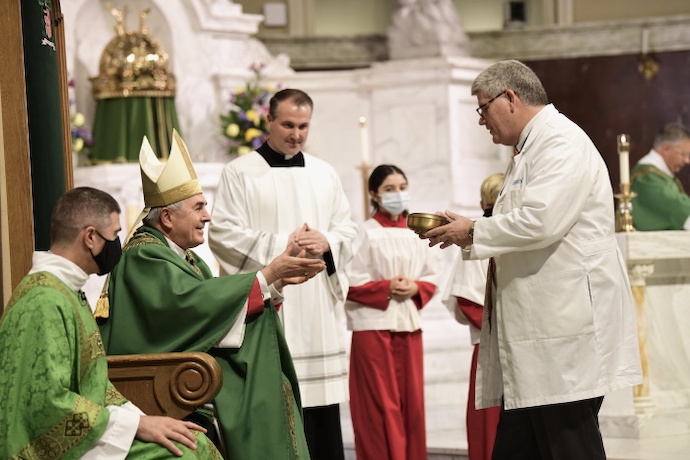In 1995, following a spate of lethal violence against abortion providers across the United States, Catholic bioethicist Dr. G. Kevin Donovan predicted that the abortion movement faced an imminent moral and logistical dilemma.
The anti-abortion movement’s extremist efforts to “seize the moral high ground” surely had the opposite effect, Donovan wrote in the Linacre Quarterly, the official publication of the Catholic Medical Association.
There was also another problem: a new drug that could dramatically alter the landscape of abortion access. With mifepristone (then called “RU-486”), abortion procedures would no longer need to be completed in a clinic. Sidewalk ministries, including those dramatic “rescues” carried out in front of clinics, would likely be rendered ineffective in stopping abortion.
Donovan’s prophecy was mostly right, only he doesn’t go back far enough in his analysis of the anti-abortion movement or his own medical association. This recent assault on medical abortion is just the latest chapter of a century-spanning power struggle between Catholic nationalist leaders, medical professionals, and the federal government.
On April 7, Judge Matthew Kacsmaryk in Amarillo, Texas blocked access to mifepristone because of its alleged “danger” to patients and medical professionals, despite the fact that, as Andrew Seidel notes here on RD, it’s safer than aspirin, that fewer than 1 percent of patients require hospitalization, and that mifepristone is used for the “full spectrum of pregnancy care”—including to treat postpartum bleeding, according to a letter from Physicians for Reproductive Health.
Kacsmaryk’s sweeping ruling catapulted mifepristone further into legal battles, with the Fifth Circuit Court of Appeals ruling late on Wednesday, April 12 that access to mifepristone can remain, for now, but with tighter restrictions. Essentially, the circuit court repealed previous FDA recommendations that permitted mifepristone to be used in medication abortions until 10 weeks of pregnancy, ruling instead that it can be used only up to seven weeks of pregnancy.
A 2021 FDA guideline also repealed the in-person administration requirement for mifepristone. Under the circuit court’s ruling, it remains unclear (in states where abortion remains at all legal) where and how the drug can be administered.
Given its popularity, safety, and effectiveness, reproductive health advocates knew that medication abortion would be the next frontier for the anti-abortion movement. Since 2002, when the FDA first approved mifepristone for use in pregnancy terminations and miscarriage management, reproductive health professionals have sought to expand abortion access through medication abortion.
In 2020, medication abortion accounted for half of all pregnancy terminations in the United States, according to reports compiled by the Centers for Disease Control and Prevention. Mifepristone can also be used safely in self-managed abortions, which are expected to increase in this post-Roe world in which 17 states currently ban or severely restrict access to abortion.
If the circuit court’s ruling remains, it will dramatically sever access to medication abortion, particularly in rural areas and states where clinic access is limited. Both the circuit court and Kacsmaryk revived the 1873 Comstock Act, which banned “lewd,” “obscene,” and “immoral” materials from being sent via mail. As a result, criminalizing the shipping of mifepristone to states where abortion is outlawed is a very real possibility.
Much has been written about Kacsmaryk, who identifies as a Roman Catholic, and his connections to Christian nationalist groups and ideologies. Less attention has been given to the group behind the lawsuit, Alliance for Hippocratic Medicine, and its connection to Catholic nationalism and medical ethics.
A spokesperson for the Catholic Medical Association confirmed to RD in an email that CMA is a founding partner of the Alliance for Hippocratic Medicine. The spokesperson also confirmed that the association currently has 2,400 members. Any other questions, the spokesperson noted, must be addressed by lawyers for Alliance Defending Freedom—the Christian legal nonprofit that argued this most recent case.
On April 11, CMA released a brief, opaque statement, in which they applauded Kacsmaryk’s initial ruling. CMA President Craig Treptow, M.D. said in the statement:
“The FDA’s approval of these dangerous chemical abortion drugs stands in direct violation of the right to life and inherit [sic] dignity each of us has from the moment of conception.”
CMA’s board representative for Alliance for Hippocratic Medicine, Dr. Michael Parker, OB-GYN, said in a statement that drugs such as mifepristone “violate our Hippocratic oath to ‘do no harm’ by taking the lives of the pre-born child.”
CMA’s position on abortion, like Kacsmaryk’s, is clear: They adhere to the Ethical and Religious Directives for Catholic Health Care Services, a code of ethics composed by the U.S. Conference of Catholic Bishops and adopted by all Catholic medical institutions. Directive 45 defines abortion as the “directly intended destruction of a viable fetus.” The directives also block most effective, non-invasive treatments for miscarriages and pregnancy-related complications.
Although some have argued that these ERDs allow for interventions, the directives are clear that doctors can only intervene if the embryo or fetus has proven to be “non-viable” and if doctors are treating a “serious pathological condition.” Doctors must argue these circumstances before an ethics committee to receive approval for life-saving interventions and treatments; often, these interventions are denied, with patients forced to travel to a non-Catholic hospital.
The USCCB positions the ERDs as a beacon of Catholic identity in an increasingly bio-medicalized healthcare system. But bio-medicalization, as I often remind my college students, is not always a threat—to the Catholic bishops or to religion in general. Rather, the bigger threat is losing what historian Kathleen Joyce, in her analysis of 20th-century Catholic hospitals, deemed “Catholic power” in American medicine.
Over the course of the 20th century, Catholic physicians sought to professionalize themselves and their institutions while retaining their Catholic identity. Matters involving the “sanctity” of human life were how Catholic physicians, often working alongside the Catholic hierarchy, made their mark on the US healthcare system.
Since its formal inception in 1932, as the National Federation of Catholic Physicians Guilds, the organization has sought to achieve this goal by inserting itself in public healthcare debates with abortion at the forefront. In 1942, NFCPG adopted a resolution that expressed “its abhorrence of the assaults on the sanctity of human life which arise from the advocacy of abortion, sterilization and planned parenthood through contraception.” The resolution also pledged allegiance to their Catholic moral principles.
A 1960 overview of the organization’s “activities” reaffirms this pledge: “To uphold the principles of the Catholic faith and morality as related to the science and practice of medicine” and “to uphold Catholic hospitals their enforcement of Catholic principles in medical practice.” (Although NFCPG/CMA has maintained various connections with the Catholic Health Association, which oversees the Catholic hospital network, the two organizations are not formally affiliated.)
This history isn’t always so neat. Catholic doctors frequently dissented from church teaching on contraception, particularly in the 1930s, when the Vatican first took up the issue, and again in the 1960s when, in a stunning last minute reversal, Pope Paul VI reaffirmed the church’s ban on all artificial contraceptives in his encyclical Humanae Vitae. Debates over contraceptive use drove rifts within the NFCPG, with membership dropping dramatically in the 1960s.
Hospital leaders and members of the Catholic hierarchy also grew concerned over the new movement to reform abortion laws, fearing it would lead to abortions being performed in Catholic settings. Although Catholic officials expanded an existing code of medical ethics in 1948 to include directives on contraception and abortion, Catholic hospitals didn’t share a unified ethical code until 1971.
Reports of hospitals in some dioceses performing abortions and providing contraception to patients led the USCCB to publish a new version of the ERDs and require every diocese to adopt them. This would prevent what Father O’Rourke, a storied Franciscan ethicist, once called “geographic immortality.”
But the reach of Catholic physicians extended beyond diocesan boundaries. What strikes me when reviewing these archival materials is the rhetoric of patriotism and civil liberties invoked by Catholic officials and physicians. When expanding the medical codes in 1948, Rev. Gerald Kelly, a Jesuit priest, told the Catholic Health Association that many non-Catholics would be “eager” to follow these ethical codes because they “pertain not merely to Catholic teaching but also to moral law.”
The 1942 NFCPG resolution also declared that abortion and contraception were an affront, not just to the Catholic, but to the American family. “Sound morality as well as sound patriotism demand the protection of the family and family fertility and the human life stream as fundamental to national well-being,” the resolution stated.
In 1970, more than 30 NFCPG members testified before an American Medical Association committee considering a recommendation from its board of trustees to repeal all abortion restrictions. According to a report from The New York Times, Catholic doctors decried abortion reform as government interference and claimed that legal abortion would “place the profession of medicine at the disposal of the government” in a manner they likened to “Nazi Germany.”
The language we see in Kacsmaryk’s ruling is only slightly more medicalized. Yes, he repeatedly refers to abortion providers as “abortionists,” medication abortions as “chemical abortions,” and patients as “post-abortive women.” But the medicalized opposition to abortion is now a bit more insidious, repurposing arguments that were once used by abortion providers under attack from both state legislators and vigilante anti-abortion activists.
Kacsmaryk positions these Catholic (and Christian) physicians as both the saviors and the burdened. He argues that physicians are forced to “remove” fetuses with “beating hearts,” placing them at the mercy of overreaching federal entities. But these physicians, according to Kacsmaryk, are also lifesavers in “maternity-care ‘deserts’”—even though a 2022 report from the March of Dimes reveals that the majority of these “deserts” are in states hostile to abortion. Indeed, it’s a moral and logistical dilemma of their own making.
The story of medicalized abortion opposition is a complicated one. For Catholic nationalist leaders, medicalizing “morality” also meant re-packaging it as a form of sacred duty and patriotism. Catholic nationalist leaders played the long game to preserve “Catholic power” in medicine and politics. But in this playbook, they’ve also become the victimized, dominant in their own narrative.





